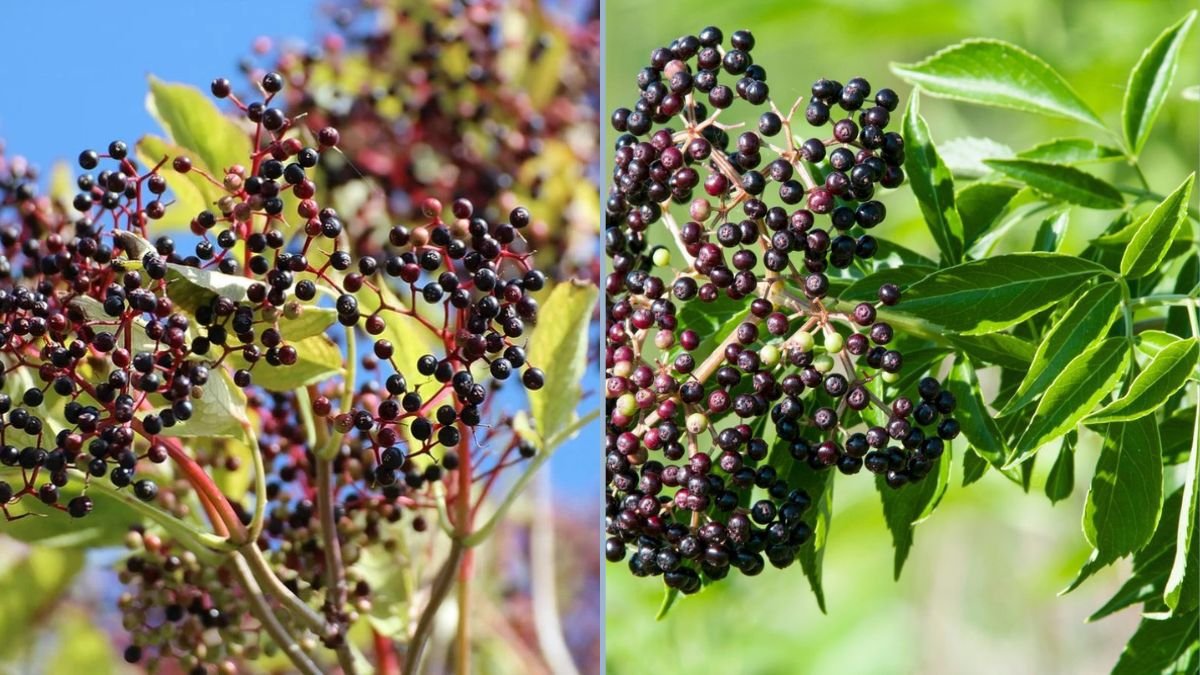Elderberries (Sambucus spp.) are nutrient-rich berries that have been celebrated for centuries for their medicinal properties, culinary uses, and ornamental value. Known for their dark purple berries and fragrant flowers, elderberries are packed with antioxidants, vitamins, and immune-boosting compounds.
Whether you are interested in making homemade syrups, jams, or teas, or simply want to add a beautiful, flowering shrub to your garden, elderberries are an excellent choice. This guide covers everything you need to know about growing elderberry plants, from selecting the right variety to harvesting your first fruits.
1. Why Grow Elderberries?
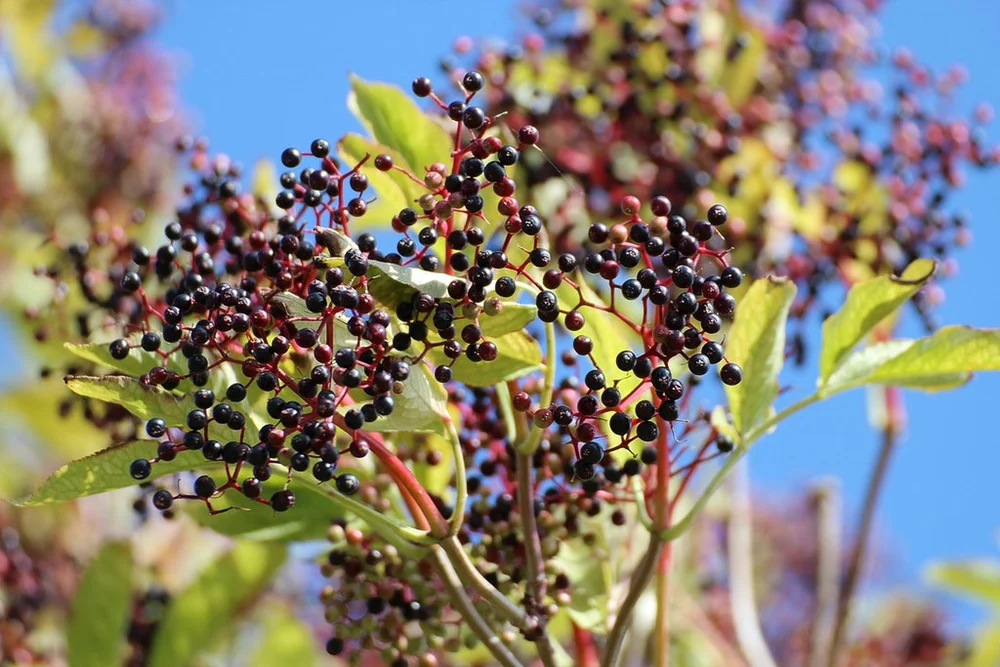
Growing elderberries at home offers several advantages:
- Nutritional and medicinal benefits: Rich in vitamin C, antioxidants, and flavonoids.
- Culinary uses: Ideal for jams, jellies, wines, syrups, and teas.
- Ornamental value: Attractive flowers, dark berries, and lush green foliage enhance garden aesthetics.
- Wildlife-friendly: Birds and pollinators are naturally attracted to elderberry shrubs.
- Low-maintenance: Hardy shrubs that adapt well to various climates.
By growing elderberries at home, you can enjoy fresh, organic berries and flowers all season long.
2. Choosing the Right Elderberry Variety
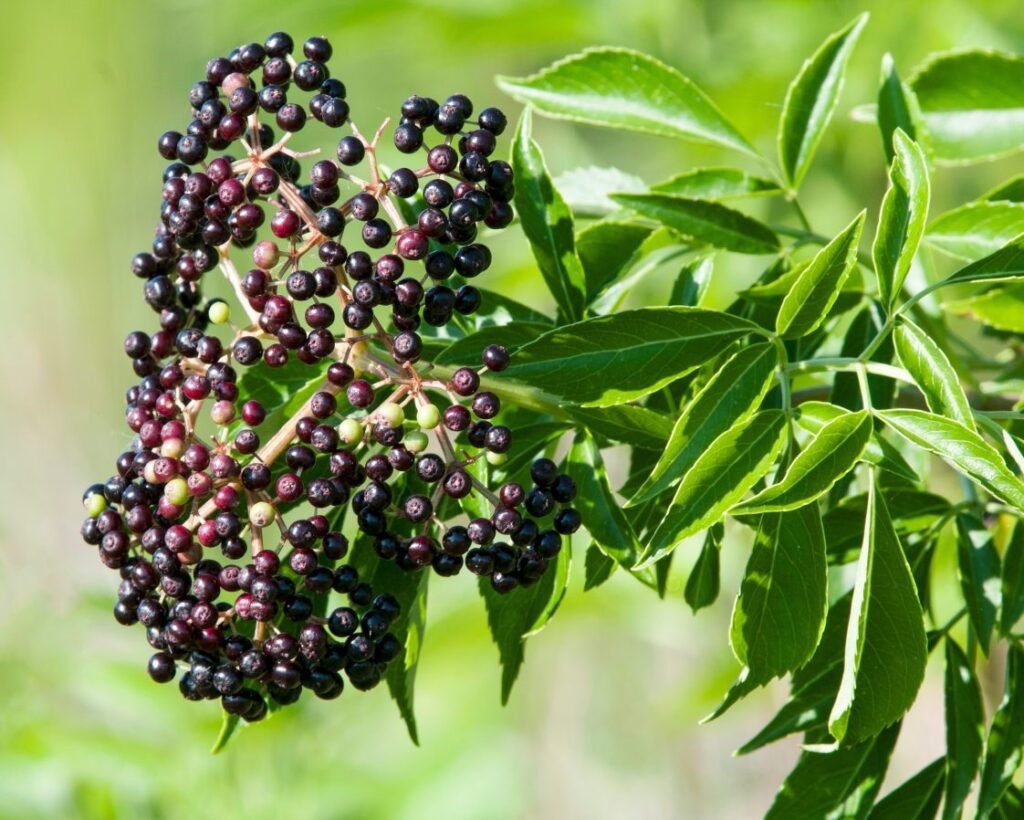
Selecting the right variety is crucial for fruit quality, growth, and climate adaptation:
- American Elderberry (Sambucus canadensis): Common in North America, produces large berries.
- European Elderberry (Sambucus nigra): Smaller berries, often used for medicinal and culinary purposes.
- Dwarf or compact varieties: Suitable for small gardens and container growth.
Choosing a variety suited to your climate and available space ensures better yields and healthier plants.
3. Propagation: Seeds, Cuttings, or Transplants
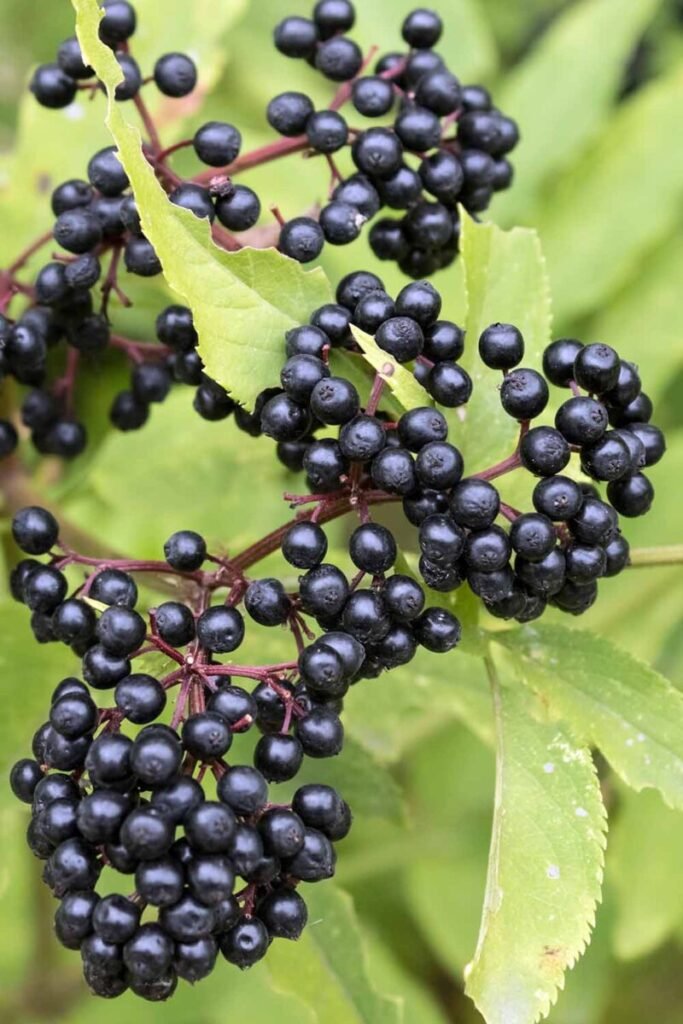
Elderberries can be propagated in multiple ways:
Seed Propagation:
- Extract seeds from ripe berries and clean thoroughly.
- Stratify seeds in the refrigerator for 2–3 months to improve germination.
- Sow in well-draining soil. Germination may take several weeks.
Cuttings:
- Hardwood cuttings from mature plants are the most reliable method.
- Take 6–12 inch cuttings, remove lower leaves, and plant in moist soil.
- Roots develop in a few weeks under proper conditions.
Transplants/Saplings:
- Young plants from nurseries provide faster establishment and fruiting.
- Ideal for beginners who want a quicker harvest.
💡 Tip: Cuttings and nursery plants are generally preferred for faster fruit production and uniformity.
4. Choosing the Right Location
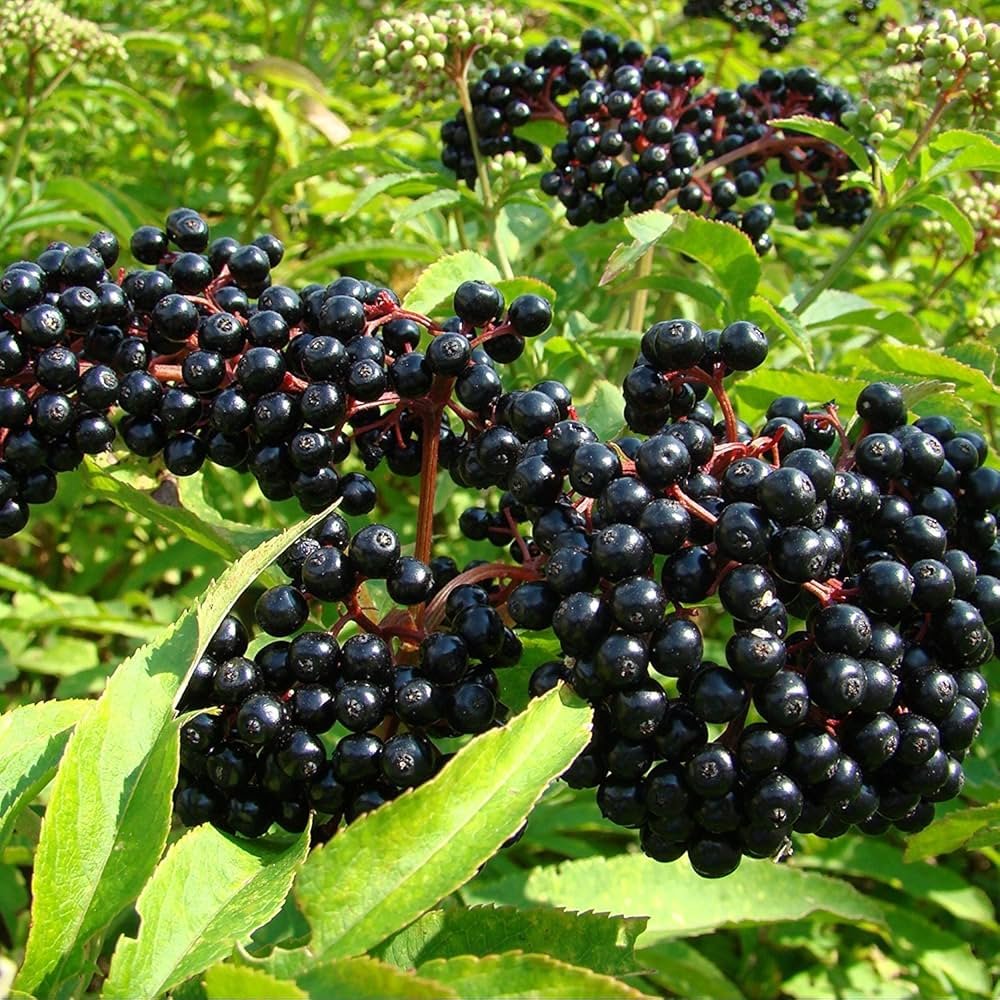
Elderberries thrive in sunlight and well-draining soil:
- Sunlight: At least 6–8 hours of direct sunlight daily.
- Soil: Loamy, fertile, and slightly acidic to neutral (pH 5.5–6.5).
- Drainage: Good drainage is essential to prevent root rot.
- Space: Allow 6–10 feet between plants to accommodate mature growth.
Proper site selection ensures healthy growth, flowering, and fruit production.
5. Planting Elderberry Shrubs
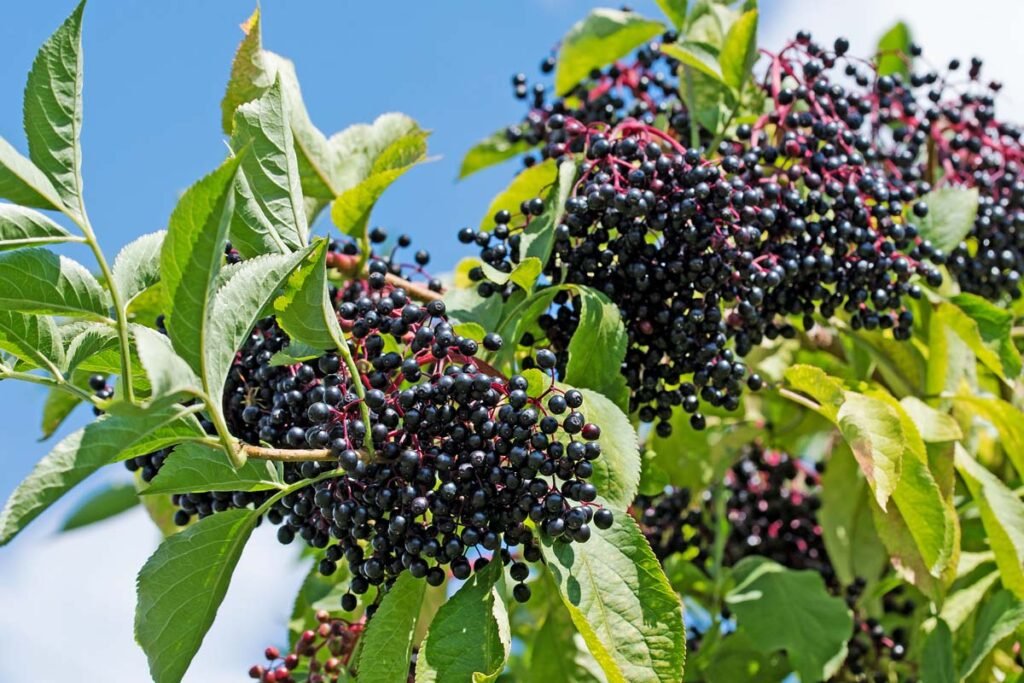
Follow these steps for successful planting:
- Dig a hole twice the width of the root ball.
- Mix garden soil with organic compost to enrich the planting site.
- Place the sapling or cutting in the hole, spreading roots evenly.
- Fill soil around the roots and firm gently.
- Water thoroughly to settle the soil and reduce air pockets.
Proper planting ensures strong root establishment and healthy shrub growth.
6. Sunlight and Temperature Requirements
Elderberries prefer full sun but can tolerate partial shade:
- Optimal sunlight: 6–8 hours per day for maximum fruiting.
- Temperature: Hardy in USDA zones 3–9; tolerates cold winters with mulch protection.
- Air circulation: Adequate airflow reduces disease incidence.
Ensuring these conditions promotes robust growth, abundant flowering, and high fruit yield.
7. Watering Elderberry Plants
Elderberries require consistent moisture, especially during establishment and fruiting:
- Water deeply 1–2 times per week, adjusting for rainfall and season.
- Mulch around the base to retain soil moisture and regulate temperature.
- Avoid waterlogging to prevent root rot.
Proper watering encourages healthy foliage, flower development, and abundant berries.
8. Fertilizing Elderberries
Fertilization supports healthy growth, flowering, and fruit production:
- Apply a balanced fertilizer (10-10-10) in early spring.
- Use organic compost or manure to enrich soil naturally.
- Fertilize every 6–8 weeks during the growing season.
- Avoid over-fertilization, which can lead to excessive leafy growth at the expense of flowers and berries.
A well-nourished elderberry plant produces strong branches, healthy flowers, and large berries.
9. Pruning Elderberry Shrubs
Pruning promotes air circulation, light penetration, and higher yields:
- Remove dead, damaged, or weak branches annually.
- Thin out crowded stems to allow light into the center.
- Cut back 1-year-old wood to encourage new growth, which produces flowers and fruit.
Proper pruning ensures vigorous plants and high-quality berry production.
10. Flowering and Pollination
Elderberries produce clusters of small white flowers:
- Flowers appear in late spring to early summer.
- Most elderberry varieties are self-fertile, but cross-pollination improves fruit set.
- Bees and other pollinators enhance natural pollination.
Healthy flowering ensures abundant, high-quality fruit development.
11. Harvesting Elderberries
Elderberries are ready to harvest when fully ripe and dark purple to black in color:
- Harvest carefully to avoid crushing berries.
- Use scissors or gently twist off clusters.
- Avoid eating raw berries without cooking; raw elderberries can be toxic.
- Frequent harvesting encourages continuous production in successive seasons.
Proper harvest ensures sweet, nutritious berries for jams, syrups, teas, or wine.
12. Common Pests and Diseases
Elderberries are hardy but can face some challenges:
- Aphids and spider mites: Spray neem oil or insecticidal soap.
- Powdery mildew and leaf spots: Improve airflow and avoid wetting leaves.
- Birds: Use netting to protect ripening berries.
Regular monitoring ensures healthy plants and bountiful harvests.
13. Companion Planting and Garden Benefits
Elderberries are versatile garden plants:
- Companion plants: Blueberries, raspberries, or other berry shrubs.
- Attracts pollinators like bees, butterflies, and beneficial insects.
- Can be used as a hedge, privacy screen, or ornamental shrub.
Companion planting enhances garden biodiversity and overall productivity.
14. Long-Term Care for Elderberries
To maintain healthy, productive shrubs:
- Mulch annually to retain moisture and suppress weeds.
- Monitor soil pH; amend with sulfur if soil becomes too alkaline.
- Repot container-grown plants every 2–3 years.
- Fertilize seasonally to maintain nutrient levels.
With proper care, elderberries can produce fruits for 15–20 years, providing long-term benefits.
15. Tips for Growing Elderberries Successfully
- Plant multiple shrubs for cross-pollination and higher yields.
- Keep young plants well-watered and mulched during the first year.
- Protect from frost using mulch or covers in colder climates.
- Harvest berries when fully ripe for the best flavor and nutritional value.
By following these tips, even beginners can enjoy healthy, productive elderberry plants.
16. Final Thoughts: Growing Elderberries at Home
Elderberries are nutritious, versatile, and visually appealing shrubs that can thrive in home gardens, backyards, and even containers. By selecting the right variety, preparing fertile soil, providing sunlight, water, fertilization, and pruning, you can grow robust elderberry plants and enjoy bountiful harvests.
Homegrown elderberries are perfect for culinary uses, medicinal preparations, and ornamental purposes, providing both health benefits and aesthetic value. With patience and consistent care, your elderberry shrubs will flourish, producing abundant, healthy berries for years to come.
Growing elderberries is a rewarding experience for gardeners of all levels. By following these step-by-step care tips, you can enjoy the full process from planting to harvest, and reap the benefits of fresh, homegrown berries right from your backyard.
